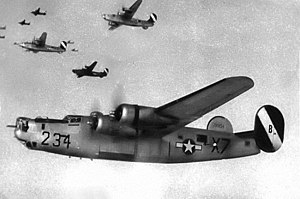
Royal Air Force Rackheath, more commonly known as RAF Rackheath, is a former Royal Air Force station located near the village of Rackheath, approximately 6 miles north-east of Norwich, in the county of Norfolk in England.

The 467th Bombardment Group is an inactive United States Army Air Forces unit. Its last assignment was to the Strategic Air Command, being stationed at Clovis Army Airfield, New Mexico. It was inactivated on 4 August 1946.

The 489th Bomb Group is a unit of the United States Air Force within the Air Force Reserve Command. It is assigned to the 307th Bomb Wing, and is stationed at Dyess Air Force Base, Texas. The group is a reserve associate unit of the 7th Bomb Wing at Dyess.

The 55th Air Refueling Squadron is an inactive United States Air Force unit. It formerly operated both the combat crew training school and central flight instructor course for Boeing KC-135 Stratotanker at Altus Air Force Base, Oklahoma.

The 715th Weapons Squadron is an inactive United States Air Force unit. It was last assigned to the USAF Weapons School at Whiteman Air Force Base, Missouri, where it served from 2003 until 9 September 2005 as an advanced training unit with the Northrop Grumman B-2 Spirit.

The 828th Bombardment Squadron was a squadron of the United States Army Air Forces. It was active during World War II in the Mediterranean Theater of Operations as a Consolidated B-24 Liberator unit, where it earned a Distinguished Unit Citation. Following V-E Day, the squadron returned to the United States and began training with the Boeing B-29 Superfortress at Smoky Hill Army Air Field, Kansas, before inactivating in August 1946 ans transferring its personnel to another unit that was activated in its place.

The 752nd Bombardment Squadron is a former United States Army Air Forces unit. The squadron was first activated in July 1943. After training with Consolidated B-24 Liberator heavy bombers in the United States, it deployed to the European Theater of Operations, where it participated in the strategic bombing campaign against Germany. Following V-E Day, the squadron returned to the United States, where it began training with Boeing B-29 Superfortresses, but was inactivated in October 1945.
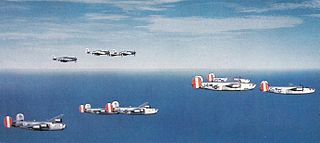
The 753rd Bombardment Squadron is a former United States Army Air Forces unit. The squadron was first activated in July 1943. After training with Consolidated B-24 Liberator heavy bombers in the United States, it deployed to the European Theater of Operations, where it participated in the strategic bombing campaign against Germany. Following V-E Day, the squadron returned to the United States, where it began training with Boeing B-29 Superfortresses, but was inactivated in October 1945.

The 754th Bombardment Squadron is a former United States Army Air Forces unit. The squadron was first activated in July 1943. After training with Consolidated B-24 Liberator heavy bombers in the United States, it deployed to the European Theater of Operations, where it participated in the strategic bombing campaign against Germany. Following V-E Day, the squadron returned to the United States, where it began training with Boeing B-29 Superfortresses, but was inactivated in October 1945.

The 785th Bombardment Squadron is a former United States Army Air Forces unit. It was organized in August 1943 as a heavy bomber unit. After training in the United States with Consolidated B-24 Liberators, the 785th moved to England, where it participated in the strategic bombing campaign against Germany. Following V-E Day, it returned to the United States, where it began training with Boeing B-29 Superfortresses, but was inactivated in October 1945.

The 872nd Bombardment Squadron is the former name of the 872nd Air Expeditionary Squadron, a provisional unit of the United States Air Force. It is assigned to United States Air Forces Europe to activate or inactivate as needed.
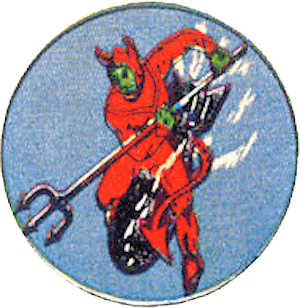
The 420th Bombardment Squadron was unit in the United States Army Air Forces. Its last assignment was with 382d Bombardment Group stationed at Camp Anza, California. It was inactivated on 4 January 1946 without seeing combat.

The 869th Bombardment Squadron is a former United States Army Air Forces unit. It was assigned to the 497th Bombardment Group, and was last stationed at MacDill Field, Florida where it was inactivated on 31 March 1946. The squadron was activated in late 1943. After training in the United States, it moved to Saipan in the Central Pacific Area, where it served in the strategic bombing campaign against Japan with Twentieth Air Force, flying Boeing B-29 Superfortress aircraft, where it earned two Distinguished Unit Citations. Following V-J Day, the squadron returned to the United States and briefly became part of Strategic Air Command before inactivating.

The 870th Bombardment Squadron is a former United States Army Air Forces unit. It was assigned to the 497th Bombardment Group, and was last stationed at MacDill Field, Florida where it was inactivated on 31 March 1946. The squadron was activated in late 1943. After training in the United States, it moved to Saipan in the Central Pacific Area, where it served in the strategic bombing campaign against Japan with Twentieth Air Force, flying Boeing B-29 Superfortress aircraft, where it earned two Distinguished Unit Citations. Following V-J Day, the squadron returned to the United States and briefly became part of Strategic Air Command before inactivating.
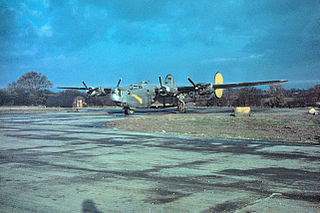
The 844th Bombardment Squadron is an inactive United States Air Force unit. It was assigned to the 489th Bombardment Group, flying Consolidated B-24 Liberators. After training in the United States, it moved to England and engaged in the strategic bombing campaign against Germany until V-E Day. It returned to United States in 1945 and began training with the Boeing B-29 Superfortress, but was inactivated at March Field, California on 17 October 1945.
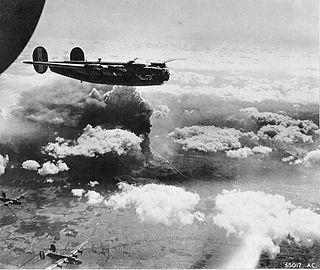
The 845th Bombardment Squadron is an inactive United States Air Force unit. It was last assigned to the 489th Bombardment Group. It was assigned to the 489th Bombardment Group, flying Consolidated B-24 Liberators. After training in the United States, it moved to England and engaged in the strategic bombing campaign against Germany until V-E Day. It returned to United States in 1945 and began training with the Boeing B-29 Superfortress, but was inactivated at March Field, California on 17 October 1945.

The 846th Bombardment Squadron is an inactive United States Air Force unit. It was assigned to the 489th Bombardment Group, flying Consolidated B-24 Liberators. After training in the United States, it moved to England and engaged in combat in the strategic bombing campaign against Germany until V-E Day. It returned to United States in 1945 and began training with the Boeing B-29 Superfortress, but was inactivated at March Field, California on 17 October 1945.

The 788th Tactical Fighter Squadron is an inactive United States Air Force unit. During World War II, as the 788th Bombardment Squadron, it was assigned to the 467th Bombardment Group as a Consolidated B-24 Liberator squadron in 1943. After training in the United States, it moved to the European Theater of Operations the following year. It saw combat until the surrender of Germany in May 1945, earning a French Croix de Guerre with Palm for its actions contributing to the liberation of France. From May to August 1944, the squadron was detached to the 801st Bombardment Group (Provisional) engaging in Operation Carpetbagger operations. After V-E Day, the squadron returned to the United States and transitioned into the Boeing B-29 Superfortress It was inactivated on 4 August 1946 at Clovis Army Air Field, New Mexico.

The 789th Tactical Fighter Squadron is an inactive United States Air Force unit. During World War II, as the 789th Bombardment Squadron, it was assigned to the 467th Bombardment Group as a Consolidated B-24 Liberator squadron in 1943. After training in the United States, it moved to the European Theater of Operations the following year, where it participated in the strategic bombing campaign against Germany. It saw combat until the surrender of Germany in May 1945. After V-E Day, the squadron returned to the United States and transitioned into the Boeing B-29 Superfortress It was inactivated on 4 August 1946 at Clovis Army Air Field, New Mexico.

The 791st Bombardment Squadron is a former United States Army Air Forces unit. During World War II it was assigned to the 467th Bombardment Group, and engaged in the strategic bombing campaign against Germany. After V-E Day, the squadron returned to the United States and transitioned into the Boeing B-29 Superfortress. It was inactivated on 31 March 1946 at Roswell Army Air Field, New Mexico in March 1946 and its resources were transferred elsewhere.
